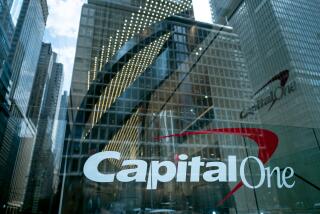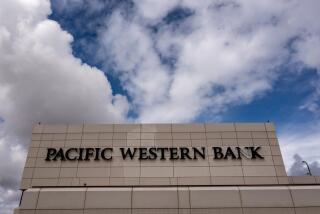Chase Agrees to Buy High-Tech Banker Hambrecht & Quist
- Share via
Banking giant Chase Manhattan Corp., looking to tap into what it sees as the highest-growth sector of the U.S. economy, agreed Tuesday to pay $1.35 billion for Hambrecht & Quist Group, a leading investment bank for fledgling high-technology and Internet firms.
Chase, the nation’s third-largest bank, with $357 billion in assets, is a leading corporate lender but has lagged its commercial-banking peers in buying an investment firm that would make it a bigger player in underwriting stock sales and advising on mergers and acquisitions.
New York-based Chase was rumored to be eyeing a merger with some of Wall Street’s largest firms, such as Merrill Lynch & Co., but no deal materialized.
Instead, its pact to buy San Francisco-based Hambrecht & Quist for $50 a share in cash is a clear statement that Chase is no longer content to serve only conventional, established businesses but wants to exploit the boom in cutting-edge technology companies.
Hambrecht & Quist is a relatively small but fast-growing investment firm that’s well-regarded for its focus on raising capital and providing merger advice for young companies involved in computers, biotechnology, media, telecommunications, entertainment and the Internet.
Hambrecht & Quist, founded in 1968 by William Hambrecht and George Quist, is widely viewed as a key player in jump-starting Silicon Valley between the late 1960s and early 1980s.
The company underwrote the initial public stock offerings of hundreds of technology companies, including many of high tech’s and biotech’s most important names. It helped take Genentech Inc. and Apple Computer Inc. public in 1980 and did likewise for publishing software titan Adobe Systems Inc. in 1986.
More recently, the company took Internet pioneer Netscape Communications Corp. (since acquired by America Online Inc.) public in 1995 and co-managed the IPO of online bookseller Amazon.com Inc. in 1997. This year, Hambrecht & Quist was the co-lead underwriter for the IPO of MP3.com Inc., a company that set the standard for distributing music over the Net.
Investors cheered the Chase deal. Hambrecht & Quist’s stock soared $7.63 a share to close at $48.69, and Chase slipped 31 cents to $73.81, both in composite trading on the New York Stock Exchange.
To be sure, Hambrecht & Quist would be able to benefit from Chase’s enormous financial horsepower. But the deal also raises questions about whether the high-tech savvy and nimbleness that has been Hambrecht & Quist’s trademark might diminish after it’s absorbed into Chase’s bureaucracy.
“That’s always that big fear, because there’s a long track record of that sort of thing happening,” said Bert Ely, who heads a bankconsulting firm bearing his name in Alexandria, Va.
“The trick is to keep the people [of Hambrecht & Quist], and I think the Chase people are fully aware of this,” he said.
Hambrecht & Quist “is an aggressive institution that’s focused on what we care about. If that becomes diluted [by the merger], that’s not a good thing,” said Jeffrey Brody, a partner with Brentwood Venture Capital on Sand Hill Road in Menlo Park, the center of Silicon Valley investing.
In an interview, executives of both companies insisted that Hambrecht & Quist would not lose its successful culture. “We know how to move fast, we know how to move smart,” said James Lee Jr., a Chase Manhattan vice chairman who heads the bank’s investment banking unit. “We don’t think there’s any issues with respect to staying nimble.”
To help prevent Hambrecht & Quist’s key employees from defecting, Chase said it’s establishing a $200-million pool of Chase stock payable to the employees over four years. Hambrecht & Quist also would change its name to Chase Securities West, and it would be headed by Hambrecht & Quist’s current chief executive, Daniel H. Case III.
“We’ve given our people strong financial incentives to give the combination a chance,” Case said.
Chase also would give Hambrecht & Quist added expertise to handle its corporate clients’ needs as they mature, such as debt financing, he said.
“One of the things we’ve done better, but not well enough, is to serve our clients’ needs as they grow,” Case said.
But maintaining Hambrecht & Quist’s success also “will depend on whether Chase lets them stay as a stand-alone operation . . . while lending additional [financial] support,” said Steven Lacey, managing editor of the IPO Report, a trade publication in New York.
Hambrecht & Quist initially prospered because larger investment banks shied away from Silicon Valley.
“There was a time when Wall Street shunned high tech,” said William Davidow, a current partner at Mohr, Davidow Ventures, a venture capital firm also on Sand Hill Road.
“It’s only been in recent years that they’ve become interested and taken it seriously,” Davidow said. “High tech was too risky, too volatile, and it wasn’t big enough. Hambrecht & Quist provided a tremendous amount of leadership on those issues.”
Mitchell Kertzman, chief executive of San Carlos, Calif.-based Liberate Technologies, a leading maker of software for interactive television, said Hambrecht & Quist, “perhaps more than anyone else, has the reputation as the purest technology investment bank.” It was the co-lead underwriter for his company’s IPO this year.
Chase’s acquisition “is not an obituary,” he said. “You need to be part of a large financial institution to do what H&Q; does well. I suspect Chase will help them do that, with greater resources.”
But he agreed that Chase needs to carefully preserve the risk-taking approach that allowed Hambrecht & Quist to exploit and feed the high-tech boom.
“At worst, the culture won’t thrive, but at best, some of the entrepreneurial culture infects the larger company,” Kertzman said.
Brody of Brentwood Venture Capital said the proposed merger is hardly surprising, given that several independent technology-focused investment banks have been acquired by big commercial banks attempting to play catch-up.
“As technology has become more and more penetrated into the economy,” he said, “some of the bigger guys have moved in in a pretty aggressive way and made it harder for the smaller guys to compete.”
(BEGIN TEXT OF INFOBOX / INFOGRAPHIC)
Bank Merger at a Glance
Chase Manhattan
The nation’s third-largest bank, with $357 billion in assets.
* 1998 sales: $32.6 billion
* 1998 net income: $3.8 billion
* Employees: 72,683
* Headquarters: New York
*
Hambrecht & Quist
Investment banker that specializes in technology and has underwritten initial public offerings for Netscape, Amazon.com and others.
* 1998 sales: $373 million
* 1998 net income: $40.2 million
* Employees: About 1,000
* Headquarters: San Francisco
Source: Associated Press
More to Read
Inside the business of entertainment
The Wide Shot brings you news, analysis and insights on everything from streaming wars to production — and what it all means for the future.
You may occasionally receive promotional content from the Los Angeles Times.











